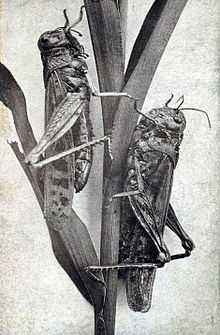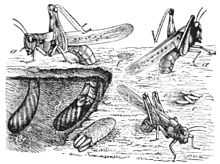Rocky Mountain locust
| Rocky Mountain locust | |
|---|---|
 | |
| Photo from the 1870s | |
| Conservation status | |
| Scientific classification | |
| Kingdom: | Animalia |
| Phylum: | Arthropoda |
| Class: | Insecta |
| Order: | Orthoptera |
| Suborder: | Caelifera |
| Superfamily: | Acridoidea |
| Family: | Acrididae |
| Subfamily: | Melanoplinae |
| Genus: | Melanoplus |
| Species: | †M. spretus |
| Binomial name | |
| †Melanoplus spretus Walsh, 1866 | |
The Rocky Mountain locust (Melanoplus spretus) is an extinct locust species that ranged through the western half of the United States and some western portions of Canada until the end of the 19th century. Sightings often placed their swarms in numbers far larger than any other species of locust, with one famed sighting estimated at 198,000 square miles (510,000 km2) in size (greater than the area of California), weighing 27.5 million tons, and consisting of some 12.5 trillion insects – the greatest concentration of animals ever speculatively guessed, according to Guinness World Records.[1]
Less than 30 years later, the species was apparently extinct. The last recorded sighting of a live specimen was in 1902 in southern Canada. Because a creature so ubiquitous was not expected to become extinct, very few samples were ever collected (though a few preserved remains have been found in Grasshopper Glacier, Montana). North America is the only continent without a major locust species, apart from Antarctica.
Distribution


The Rocky Mountain locust largely afflicted prairie areas, though they existed on both sides of the Rocky Mountains. Breeding in sandy areas and thriving in hot and dry conditions, they were often guaranteed a good food supply by prairie plants which concentrate sugars in their stalks in times of drought. Movement of the locusts was probably assisted by a low-level jet stream that persists through much of central North America.
Extinction
The last major swarms of Rocky Mountain locust were between 1873 and 1877, when the locust caused $200 million in crop damage in Colorado, Kansas, Minnesota, Missouri, Nebraska, and other states. The cause of their extinction was probably the plowing and irrigation by settlers that disrupted the natural life cycle of the insects in the very small areas where they lived in between swarms.[2] Reports from this era suggest that farmers killed over 150 egg cases per square inch while plowing, harrowing or flooding.[2]:11–12
Because locusts are a form of grasshopper that appear when grasshopper populations reach high densities, it was theorized that M. spretus might not be extinct, that "solitary phase" individuals of a migratory grasshopper might be able to turn into the Rocky Mountain locust given the right conditions. However, breeding experiments using many grasshopper species in high-density environments have attempted to invoke the famous insect without success. Analysis of mitochondrial DNA from museum specimens and related species suggests that the Rocky Mountain locust was a distinct and now extinct species, possibly closely related to the Bruner spurthroat grasshopper (Melanoplus bruneri).[3]
The species was formally declared extinct by the IUCN in 2014.[4]
In literature
A fictionalized description of the devastation created by Rocky Mountain locusts in the 1870s can be found in the 1937 novel On the Banks of Plum Creek by Laura Ingalls Wilder. Her description was based on actual incidents in western Minnesota during the summers of 1874 and 1875 as the locusts destroyed her family's wheat crop.[5]
Another vivid portrayal of the depredations of the locust can be found in Ole Edvart Rølvaag's Giants in the Earth, based in part on his own experiences and those of his wife's family.
See also
References
| Wikimedia Commons has media related to Melanoplus spretus. |
- Footnotes
- ↑ "Melanoplus spretus, Rocky Mountain grasshopper". Animal Diversity Web. University of Michigan Museum of Zoology. Retrieved 2009-04-16.
- ↑ 2.0 2.1 Lockwood, Jeffrey A. (2004). Locust: the Devastating Rise and Mysterious Disappearance of the Insect that Shaped the American Frontier (1st ed.). New York: Basic Books. ISBN 0-7382-0894-9.
- ↑ Chapco, W.; Litzenberger, G. (March 2004). "A DNA investigation into the mysterious disappearance of the Rocky Mountain grasshopper, mega-pest of the 1800s". Molecular Phylogenetics and Evolution 30 (3): 810–814. doi:10.1016/S1055-7903(03)00209-4.
- ↑ Hochkirch, A. (2014). "Melanoplus spretus". IUCN Red List of Threatened Species. Version 2014.3. International Union for Conservation of Nature. Retrieved 2014-12-31.
- ↑ Yoon, Carol Kaesuk (23 April 2002). "Looking Back at the Days of the Locust". The New York Times. Retrieved 2015-04-01.
- General references
- Ryckman, Lisa Levitt (22 June 1999). "The Great Locust Mystery". Denver Rocky Mountain News. Retrieved 2013-03-31.
- Samways, M.J.; Lockwood, J.A. (1 January 1998). "Orthoptera conservation: pests and paradoxes". Journal of Insect Conservation 2 (3/4): 143–149. doi:10.1023/A:1009652016332.
